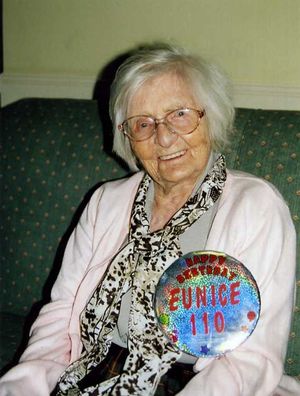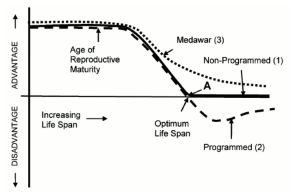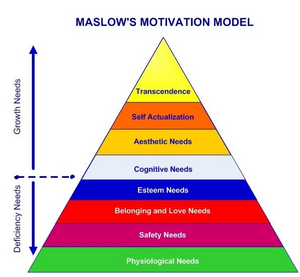Continuity Theory Of Aging Examples
Biological Ageing [edit | edit source]

Virtually people will live to experience crumbling. Historic period-related deterioration is affecting an ever-growing number of people. Although the process is unavoidable, it is important to empathise the process. As a physiotherapist, we might be able to positively influence aspects that maintain or engender better health and wellness every bit a person ages, treating and ameliorating symptoms of mutual conditions associated with aging.
In the by, maximum life span (the maximum biological limit of life in an ideal environs) was not thought to be bailiwick to change with the process of aging considered non-adaptive, and subject to genetic traits. In the early 1900s, a series of flawed experiments by researcher Alexis Carrel demonstrated that in an optimal environment, cells of higher organisms (chickens) were able to divide continually, leading people to believe our cells to potentially possess immortal properties. In the 1960's Leonard Hayflick[1] disproved this theory past identifying a maximal number of divisions a human cell could undergo in civilisation (known equally the Hayflick limit), which set our maximal life span at around 115 years. Life span is the central to the intrinsic biological causes of crumbling, every bit these factors ensure an private's survival to a certain point until biological crumbling eventually causes death.
There are many theories about the mechanisms of age-related changes, and they are mutually exclusive, no i theory is sufficiently able to explain the process of crumbling, and they often contradict one another. A literature review[2] highlights that centenarians take healthy ageing considering of the filibuster in processes like physiological decline and historic period-related diseases or syndromes. The review discusses that genetic component which plays an of import role in longevity. The researchers propose that biological science of centenarians yields a central for intervention to promote healthy ageing in the full general population.
Modernistic biological theories of aging in humans currently fall into two main categories: programmed and damage or error theories.
The programmed theories imply that aging follows a biological timetable (regulated by changes in cistron expression that affect the systems responsible for maintenance, repair and defence responses), and the damage or error theories emphasize environmental assaults to living organisms that induce cumulative damage at various levels as the cause of crumbling[3].
These two categories of theory[4] are also referred to every bit non-programmed aging theories based on evolutionary concepts (where ageing is considered the result of an organism'south disability to ameliorate gainsay natural deteriorative processes), and programmed ageing theories (which consider ageing to ultimately exist the event of a biological mechanism or programme that purposely causes or allows deterioration and death in order to obtain a directly evolutionary do good achieved by limiting lifespan beyond a species-specific optimum lifespan (Figure 1).

Figure 1: Evolutionary price/ benefit of additional lifespan vs. age.
- Bend 1: Modern non-programmed aging theories – The evolutionary value of farther life and reproduction is effectively zero across some species-specific age.
- Curve ii: Modern programmed aging theories – There is an evolutionary cost associated with surviving beyond a species-specific historic period.
- Curve iii: Medawar's concept – The evolutionary value of survival and reproduction declines with age following a species-specific age[4].
Goldsmith's review of modern programmed (adaptive) theories of biological ageing investigates how organisms have evolved mechanisms that purposely limit their lifespans in order to obtain an evolutionary benefit.
Theories of Ageing [edit | edit source]
This video gives a good introduction to the theories of aging
[5]
In his review of the modern theories of ageing, Jin[iii] highlights three sub-categories of the programmed theory, and 4 sub-categories of the damage or error theory, and too relates some to how these might be observed in ageing populations.
Biological Theories of Aging [edit | edit source]
The Programmed Theory [edit | edit source]
one) Programmed Longevity, which considers ageing to be the result of a sequential switching on and off of certain genes, with senescence existence defined every bit the time when age-associated deficits are manifested.
ii) Endocrine Theory, where biological clocks act through hormones to control the step of ageing.
3) Immunological Theory, which states that the immune system is programmed to decline over fourth dimension, leading to an increased vulnerability to infectious disease and thus ageing and death.
The Damage or Error Theory [edit | edit source]
one) Wear and tear theory, where vital parts in our cells and tissues clothing out resulting in ageing.
2) Charge per unit of living theory, that supports the theory that the greater an organism'due south rate of oxygen basal, metabolism, the shorter its life bridge
iii) Cross-linking theory, according to which an accumulation of cross-linked proteins damages cells and tissues, slowing down bodily processes and thus event in ageing.
iv) Costless radicals theory, which proposes that superoxide and other free radicals cause damage to the macromolecular components of the cell, giving rise to accumulated damage causing cells, and somewhen organs, to stop functioning.
Farther Theories [edit | edit source]
Trindade et al[6] provide a dissimilar viewpoint again, stating that to understand the evolution of ageing, we accept to empathise the surround-dependent residue between the advantages and disadvantages of extended lifespan in the process of spreading genes. These researchers have developed a fitness-based framework in which they categorise existing theories into 4 basic types: secondary (beneficial), maladaptive (neutral), assisted death (detrimental), and senemorphic aging (varying between beneficial to detrimental).
Some of the more commonly discussed theories and their relation to ageing are summarised below:
Disengagement Theory[7] [edit | edit source]
- Refers to an inevitable process in which many of the relationships between a person and other members of guild are severed & those remaining are altered in quality.
- Withdrawal may be initiated past the ageing person or past gild, and may be fractional or full.
- It was observed that older people are less involved with life than they were equally younger adults.
- Every bit people historic period they experience greater distance from society & they develop new types of relationships with club.
- In America there is evidence that guild forces withdrawal on older people whether or not they want it.
- Some suggest that this theory does non consider the large number of older people who practice not withdraw from order.
- This theory is recognised equally the start formal theory that attempted to explain the process of growing older.
Action Theory [eight] [edit | edit source]
- Is another theory that describes the psychosocial ageing procedure.
- Activity theory emphasises the importance of ongoing social activity.
- This theory suggests that a person'southward cocky-concept is related to the roles held by that person i.e. retiring may not be so harmful if the person actively maintains other roles, such as familial roles, recreational roles, volunteer & community roles.
- To maintain a positive sense of self the person must substitute new roles for those that are lost considering of historic period. And studies show that the blazon of activeness does matter, just as it does with younger people.
The Neuroendocrine Theory[9] [10] [edit | edit source]
- First proposed by Professor Vladimir Dilman and Ward Dean Dr., this theory elaborates on wear and tear by focusing on the neuroendocrine system.
- This system is a complicated network of biochemicals that govern the release of hormones which are altered past the walnut sized gland called the hypothalamus located in the brain.
- The hypothalamus controls various chain-reactions to instruct other organs and glands to release their hormones etc. The hypothalamus also responds to the body hormone levels as a guide to the overall hormonal activeness. But as we grow older the hypothalamus loses information technology precision regulatory power and the receptors which uptake private hormones become less sensitive to them. Accordingly, every bit nosotros age the secretion of many hormones declines and their effectiveness (compared unit to unit) is also reduced due to the receptors down-grading
The Free Radical Theory[nine] [edit | edit source]
- This at present very famous theory of aging was developed[11] by Denham Harman Physician at the University of Nebraska in 1956. The term costless radical describes any molecule that has a complimentary electron, and this property makes it react with healthy molecules in a destructive way.
- Because the free radical molecule has an extra electron it creates an actress negative charge. This unbalanced energy makes the gratis radical bind itself to another balanced molecule as it tries to steal electrons. In so doing, the balanced molecule becomes unbalanced and thus a gratis radical itself.
- It is known that diet, lifestyle, drugs (due east.one thousand. tobacco and booze) and radiations etc., are all accelerators of free radical production within the trunk.
The Membrane Theory of Aging [edit | edit source]
- The membrane theory of crumbling was kickoff described[12] past Professor Imre Zs.-Nagy of Debrechen University, Hungary. According to this theory information technology is the historic period-related changes of the jail cell's ability to transfer chemicals, heat and electrical processes that impair information technology.
- As we grow older the cell membrane becomes less lipid (less watery and more solid). This impedes its efficiency to acquit normal office and in particular there is a toxic accumulation
The Decline Theory [edit | edit source]
- The mitochondria are the power producing organelles found in every prison cell of every organ. Their main job is to create Adenosine Triphosphate (ATP) and they do and so in the diverse energy cycles that involve nutrients such as Acetyl-L-Carnitine, CoQ10 (Idebenone), NADH and some B vitamins etc.[9]
- Enhancement and protection of the mitochondria is an essential office of preventing and slowing aging. Enhancement tin can be achieved with the to a higher place mention nutrients, as well as ATP supplements themselves
The Cross-Linking Theory [edit | edit source]
- The Cross-Linking Theory of Aging[xiii] is also referred to every bit the Glycosylation Theory of Aging. In this theory it is the binding of glucose (uncomplicated sugars) to protein, (a process that occurs under the presence of oxygen) that causes various issues.
- In one case this binding has occurred the protein becomes impaired and is unable to perform as efficiently. Living a longer life is going to pb to the increased possibility of oxygen coming together glucose and protein and known cross-linking disorders include senile cataract and the appearance of tough, leathery and xanthous peel.
Farther information on video [edit | edit source]
In addition to these explanations, you tin can encounter several presentations about the biological theories of ageing on YouTube:
The Wearable and Tear Theory:
The ageing Academy's series on Crumbling: Stem Cells, long Lived Proteins, Prison cell Programming, Cistron Expression:
A Large Think monologue by Michio Kaku looking at what enzymes similar Telomerase and Resveratrol offer:
[fourteen]
- See also - Policy and Initiatives Focused on the Older Population
Psychological Theories of Aging [edit | edit source]
The earliest known theories on aging were known to be psychological theories. As the age increases these theories deals with the changes in the behavior, mental attitude towards life and personality modifications or ego evolution in an private. The psychological theories of aging focus on the changes in mental processes, emotions, attitudes, motivation and personality adaptations equally per the physical, social or environmental demands. This power of adaptation is believed to be influences past irresolute roles with age, human relationship changes, condition change in a order. [15]
Human Needs Theory [edit | edit source]
Developed past Maslow in 1954, this theory focuses on the fact that human beliefs is motivated past their needs with historic period. These needs are; physiological, rubber and security, love and belongingness, self-esteem, and actualization. [xv]
- Physiological needs: The desire to obtain food, h2o, and shelter is great, and the type of behaviors that ensure these things are reinforced. Most people don't demand help with this, just some people, peculiarly those with cognitive disabilities, may need information technology.[16]
- Prophylactic and Security: This kind of demand has both short-term and long-term repercussions, such equally staying abroad from harmful places and attempting to constitute a safer order. These are more than abstruse requirements than food, water, and shelter, and continuing to seek them requires some projective reasoning. While hunger, thirst, and exposure to the elements are instinctive, it tin can be difficult to notice and adjust to subtle threats to safety or security. Because the rewards of acquiring food are immediate and visceral, the sorts of preparation continued with these requirements are also significantly different than those related with physical needs, because the need for security is ofttimes realized only when it is threatened or lost.[16] [17]
- Belongingness and Love: The chapters to interact via phone, electronic mail, or social networking sites significantly boosts the chances of belonging. Families of patients with cerebral impairments frequently seek out means to see their loved ones' demands for belonging and love, remaining "most" continued across location and time. Patients with even severe cerebral disabilities value homo contact considering the rewards of belonging and amore are quick and straightforward.[16]
- Esteem needs: People desire to exist believed in and respected. In terms of money, this entails accomplishing activities that a person values. Restricting someone's ability to engage in such activities can lower their cocky-esteem.[sixteen]
- Self-appearing needs: Being loyal to one'southward own nature and pursuing self-fulfillment via inventiveness are the greatest levels of human being wants. When all previous levels of need take been met, cocky-appearing tin exist attained by engaging in things that make you experience fully alive or participating in something with greater meaning. Artistic interests, professional person jobs, humanitarian activities, social projects, and hobbies, too as mature and tolerant attitudes to dealing and communicating, are all means to meet this desire.[16]

Individualism Theory [edit | edit source]
Proposed by Jung in 1960, Our personality evolves over time and is made upward of ego and self-identity, which are both personal and collectively unconscious. A private emotion or perception surrounding of import people or life events is known as personal unconsciousness.[16]
Life-Course (Lifespan development) Theory [edit | edit source]
Came into existence in 1980s past behavioral psychologists who decided to shift from personality evolution as the basis of agreement aging to the concept of 'life form'. This theory divides life course into anticipated pattern of stages that are formed according to goals, relationships and internal values. This theory focuses on the interconnectedness of individual and society.[17]
Selective Optimization and Compensation Theory [edit | edit source]
Proposed past Baltes in 1987. He believed that people over fourth dimension learn to cope upwards with the individual losses of crumbling through a procedure of choice, optimization and bounty. As an individual age, the adaptation is done by the process of optimizing more satisfying roles in life. Baltes believes that selected optimization combined with bounty is a good for you coping strategy that helps people age successfully.[xvi] [17]
References [edit | edit source]
- ↑ Hayflick Fifty. Theories of biological aging. Experimental Gerontology. 1985; 20:145-159. Accessed 25 September 2018.
- ↑ Borras C, Ingles Yard, Mas-Bargues C, Dromant K, Sanz-Ros J, Román-Domínguez A, Mallench-Gimeno 50, Gambini J, Viña J. Centenarians: An excellent example of resilience for successful ageing. Mechanisms of Ageing and Evolution. 2019 Dec 31:111199.
- ↑ iii.0 three.1 Jin M. Modernistic biological theories of ageing. Aging Dis. 2010; i(2): 72–74. Accessed 25 September 2018.
- ↑ 4.0 4.one Goldsmith TC. Modern evolutionary mechanics theories and resolving the programmed/non-programmed aging controversy. Biochemistry (Mosc). 2014; 79 (10): 1049 - 55.
- ↑ Piled higher and deeper. Theories if ageing Available from: https://www.youtube.com/picket?v=jc4yK0zZ-cQ (last accessed 23.5.2019)
- ↑ Trindade LS, Aigaki T, Peixoto AA. A novel nomenclature organization for evolutionary crumbling theories. Front Genet. 2013; 6 (4): 25. Accessed 25 September 2018.
- ↑ Achenbaum WA, Bengtson VL. Re-engaging the Disengagement Theory of Crumbling: on the history and assessment of theory. Development in Gerontology. Gerontologist. 1994; 34(6): 756–763.
- ↑ Diggs J. Activity Theory of Aging. In: Loue S.J., Sajatovic M. (eds) Encyclopedia of Crumbling and Public Health. Springer, Boston, 2008.
- ↑ 9.0 9.ane 9.2 Weinert BT, Timiras PS. Invited review: theories of aging. Appl Physiol. 2003; 95: 1706–1716. Accessed 25 September.
- ↑ Dean W. Neuroendocrine Theory of Aging: Chapter 2 Adaptive Homeostat Dysfunction. Accessed 25 September 2018 fromhttps://warddeanmd.com/articles/neuroendocrine-theory-of-aging-chapter-two/
- ↑ Harman, D. Crumbling: a theory based on free radical and radiations chemistry. J Gerontol. 1956;11 (3): 298–300.
- ↑ Zs.-Nagy I. The Membrane Hypothesis of Aging. Florida: CRC Press, 1994.
- ↑ Zs.-Nagy I, Nagy 1000. On the role of cross-linking of cellular proteins in aging. Mech Ageing Dev. 1980; 14 (i–ii): 245-251.
- ↑ Big ThinkMichio Kaku: How to Reverse Aging | Large Remember Available fromhttps://www.youtube.com/watch?v=DV3XjqW_xgU&characteristic=emb_logo
- ↑ 15.0 15.i Lange J, Grossman S. Theories of aging. Gerontological nursing competencies for care. 2010 Oct 25:50-73.
- ↑ 16.0 16.i 16.ii sixteen.three 16.4 16.5 16.6 Thielke Due south, Harniss M, Thompson H, Patel Due south, Demiris K, Johnson Thousand. Maslow's hierarchy of human needs and the adoption of wellness-related technologies for older adults. Ageing international. 2012 December;37(4):470-88.
- ↑ 17.0 17.1 17.2 Meiner SE. Gerontologic nursing-east-book. Elsevier Wellness Sciences; 2013 Aug 7.
Continuity Theory Of Aging Examples,
Source: https://www.physio-pedia.com/Theories_of_Ageing
Posted by: goodnightmeaust.blogspot.com


0 Response to "Continuity Theory Of Aging Examples"
Post a Comment